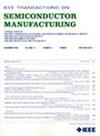Optimizing Scanning Acoustic Tomography Image Segmentation With Segment Anything Model for Semiconductor Devices
IF 2.3
3区 工程技术
Q2 ENGINEERING, ELECTRICAL & ELECTRONIC
引用次数: 0
Abstract
In recent decades, Scanning Acoustic Tomography (SAT) has become a vital technique for characterizing semiconductor devices in non-destructive evaluation. Precise and efficient segmentation of SAT images is crucial for detecting defects and assessing material properties in the semiconductor industry. However, current manual methods are often expensive and susceptible to human error. This study enhances the segmentation process of SAT images using the deep learning model SemiSA, which is fine-tuned from the Segment Anything model. In our experiments, SemiSA was trained and evaluated on a large-scale dataset from the Ohlabs TSAM-400 system, encompassing various semiconductor devices such as Flip Chip, Power Semiconductor, 6-inch and 12-inch Wafer, Transistor, and Multilayer Ceramic Capacitor. The results demonstrate that SemiSA significantly improves segmentation tasks across all types of SAT images of semiconductor devices. On average, there was a 17.89% enhancement in Dice Similarity Coefficient scores and a 24.26% improvement in Intersection over Union scores across all tasks. Additionally, this work also proposes an efficient framework tailored specifically for SAT images. The main objective of developing this segmentation tool is to provide researchers and experts with a valuable tool for advancing the semiconductor evaluation and quality control field. The code is available at利用半导体器件分段模型优化扫描声断层扫描图像分割
近几十年来,扫描声断层扫描(SAT)已成为无损评估半导体器件特性的重要技术。对 SAT 图像进行精确、高效的分割对于半导体行业检测缺陷和评估材料特性至关重要。然而,目前的手动方法往往成本高昂,而且容易出现人为错误。本研究使用深度学习模型 SemiSA 增强了 SAT 图像的分割过程,该模型由 Segment Anything 模型微调而来。在我们的实验中,SemiSA 在来自 Ohlabs TSAM-400 系统的大规模数据集上进行了训练和评估,该数据集涵盖了各种半导体器件,如倒装芯片、功率半导体、6 英寸和 12 英寸晶圆、晶体管和多层陶瓷电容器。结果表明,SemiSA 显著改善了所有类型半导体器件 SAT 图像的分割任务。平均而言,在所有任务中,骰子相似系数得分提高了 17.89%,交叉比联合得分提高了 24.26%。此外,这项工作还提出了一个专门针对 SAT 图像的高效框架。开发该分割工具的主要目的是为研究人员和专家提供一个有价值的工具,以推动半导体评估和质量控制领域的发展。代码见 https://github.com/ThuHa96/SemiSA。
本文章由计算机程序翻译,如有差异,请以英文原文为准。
求助全文
约1分钟内获得全文
求助全文
来源期刊

IEEE Transactions on Semiconductor Manufacturing
工程技术-工程:电子与电气
CiteScore
5.20
自引率
11.10%
发文量
101
审稿时长
3.3 months
期刊介绍:
The IEEE Transactions on Semiconductor Manufacturing addresses the challenging problems of manufacturing complex microelectronic components, especially very large scale integrated circuits (VLSI). Manufacturing these products requires precision micropatterning, precise control of materials properties, ultraclean work environments, and complex interactions of chemical, physical, electrical and mechanical processes.
 求助内容:
求助内容: 应助结果提醒方式:
应助结果提醒方式:


